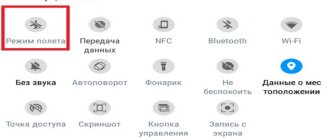If the inscription MTS RUS EDGE appears on your mobile phone near the communication bars and you regularly receive annoying SMS messages with the same text from Channel-50, then this material is for you. From this article you will learn what this inscription means, how to remove it and how to stop receiving such SMS notifications.
SMS alerts from MTS EDGE
What does the MTS Edge sign say?
The inscription MTS Edge appears on the screen of the mobile device next to the signal strength indicator when the subscriber connects to a base station that supports Edge technology.
This wireless Internet access technology appeared and gained popularity in 2000, much earlier than the popular 3g 4g.
Third and fourth generation wireless Internet connection technologies are more productive, but are not supported throughout the country. Therefore, in regions that still remain outside 3 and 4g coverage, Edge technology is widespread, which is also supported in early smartphone models.
Comparing Edge speeds with 3g and 4g technologies
| Edge | 3g, 4g |
| 20-400 kb/s | 3.8-180 Mb/s |
The appearance of the EDGE connection in question
In order for data transfer to take place via the EDGE standard, special equipment must be installed. In this case, the receiving device must have a similar function. This technology appeared back in 2003 in the United States.
The invention of new technology has significantly expanded the capabilities of mobile devices. Due to the fact that wireless networks in their speed of development do not lag behind the production of mobile devices and has led to the emergence of modern standards used throughout the world.
How to turn off public notification
GSM and Edge networks provide a standard function - public notification, or Cell Broadcast. Its task is to display the names of areas, metro stations, telephone codes and other information.
In early phone models, this information was unobtrusively displayed on the screen under the cellular operator logo. In new smartphones, broadcast notifications come in the form of SMS messages.
This means they distract the owner and take up space in the device’s memory.
Another disadvantage of the alert function is that the phone battery drains quickly.
If the user has no need to receive such messages, you need to know how to disable them on mobile devices operating on the MTS edge 4g network.
To do this you need:
- Go to the “Messages” menu.
- In the “Settings” tab, open “SMS/MMS Options”.
- Select “Public Alert” and uncheck the box.
Afterword
In conclusion, I can say one more thing. They write on the Internet that it is possible to disable the public notification on the operator’s side by executing some USSD command, but we were unable to find such a solution. Operators refer this problem to the smartphone manufacturer. Therefore, I would really like to hear the opinion of Lenovo representatives regarding this problem on their devices.
Notifications are a feature that distinguishes the Android operating system. In the 2000s, we could not even imagine that in the future individual applications would learn to notify about certain events - previously, even the operating system itself could only tell about a received SMS message or email. But some people consider Push notifications to be a natural evil. The fact is that the developers of many programs go beyond all limits of reason. Notifications from such applications pour in like a river. They may also contain advertising, which no one wants to be distracted by. That's why many people think about how to set up notifications on Android.
Previously, you couldn’t even dream of managing notifications. The user considered it lucky if the application developer included in the “ Settings”
» item regarding Push notifications. If it was not there, then they could only be disabled by the so-called “freezing” of the utility. But then the meaning of her presence on the smartphone was lost.
Fortunately, the situation has now changed. This happened with the release of Android 5.0. Google has made sure that the owner of a tablet or smartphone can easily configure the appearance of certain notifications. Moreover, from now on you can turn off notifications from a specific application with just a couple of touches on the screen, using the corresponding panel. And in future versions of Android, even more global customization of the notification panel will be available, which should make the user’s life even easier.
How to quickly remove an icon
Now that you know what MTC Edge is and what it means, you should figure out how to remove the icon confirming your connection to the network.
This can be done in three steps:
- Open the smartphone's basic settings menu.
- Go to the “Network” section.
- Uncheck the box next to “Data transfer”.
This method is fast, but there is one caveat. Once the icon disappears from the screen, access to the network will be closed.
Then, with each new connection to the network, the icon with the corresponding inscription will appear again - depending on the location of the station with the Edge module.
Consequently, it will disappear when leaving the network coverage area.
An alternative way to get rid of the MTC Edge sign
In this case, you will need to install an application on your smartphone called “Carrier Name”. Its function is to change the text specified by the mobile operator to any other text independently selected by the device owner.
The user can set any short phrase that he likes - positive and motivating.
Disabling SMS messages MTS Edge
Information about being in the Edge network coverage area, which comes to MTS subscribers in the form of SMS messages, is often intrusive and annoying.
Within one day, the phone may receive two to three dozen such notifications, due to which the user risks missing information that is important to him.
To disable network messages, you need to:
- Go to messages.
- Open the settings section.
- Select “Network messages”, and then select the “Disable” option.
What does mts edge mean? Disabling the EDGE network on your phone
Your question:
How to disable Edge on your phone?
Master's answer:
In some cases, it becomes imperative to disable GPRS/EDGE data in your mobile phone. For example, this function is absolutely not needed in roaming conditions. Another example of the need to disable this function is excessive traffic.
For Samsung phone models, the function is disabled via the request *#4777*8665#. In the “Attach mode settings” menu, select the “gprs detach” item and uncheck it. After this, the phone is turned off and rebooted, as a result of which the function is deactivated.
To disable the EDGE service, you need to change the APN access parameters - through it this service comes to the phone. For example, you can put a dot at the end of the address and the function will not work. If you request data, you will receive the message “Service not connected” in response, so no information will be transferred. Resetting the setting is simple - just remove the dot and the address will become correct.
You can use the SBSetting utility. Such a program can be found on the Internet, where it is available and free. After installing the program on your mobile phone, you need to go to the menu and find the option to enable/disable EDGE.
It is not difficult to disable the function for owners of iPhone iOS 4.0. In the phone menu, select the “Settings” section, then “General” - “Network”. The Cellular Data option must be disabled. After turning it on, not a single program will enter the Internet via GPRS traffic.
The subscriber needs to go to the mobile Internet - the Safari browser. The link “iPhone No Data.Com” takes you to the specified resource. Having found the “Turn off EDGE/3G” button (it means turning off), you need to press it. A dialog box with the “Install” button will open on the screen, after clicking on it, a dialog box with the “Install Now” button will appear. Clicking the button will turn off the EDGE service on your iPhone. If the subscriber uses WiFi connection, this function can not be turned off.
Beeline network subscribers can contact the customer service of their mobile operator. The operator must disable it, which connects automatically. This service is responsible for providing the EDGE service. When it becomes zero, the phone will be offline. You can also ask your operator to deactivate GPRS. The fact is that EDGE is a simple extension that makes GPRS work at a higher speed.
Historically, the life of a modern person becomes more and more information-rich every year. It is not always possible in the everyday bustle to extract interesting news from the information flow, a description of technological innovations, or simply a recipe for a new dish from “old” products.
Today we're going to talk about EDGE (pronounced edge). What is the EDGE network? In fact, this combination of letters GPRS/EDGE refers to mobile communications. More precisely, we are talking about the technology of transmitting data over long distances without the use of wires. In addition to voice communications, operators provide the ability to transmit data using mobile phones.
***Brief information: in addition to voice, familiar mobile phones can also transmit/receive data (information in digital form) - photographs, music, video, text. In addition, the ability to transfer data allows you to use the version of communication programs (SKYPE, ICQ) and view pages of Internet resources using a browser.
The subscriber pays not for the time spent on the network, but for the amount of downloaded/transmitted information (traffic). The use of packet data does not interfere with voice communication - the line is not busy, you can talk and transmit/receive data in parallel.
Initially, data was transmitted to operators using GPRS technology (transmission speed up to 171.2 kbit/s, real speed - within 30 kbit/s). These speeds were clearly not enough for comfortable work with data. In 2004, several US cellular operators began using the new EDGE standard for data transmission. What is EDGE? The standard was three times higher than when using GPRS. This significantly increased the attractiveness of their offerings compared to their competitors.
Gradually, EDGE moved overseas and spread among European mobile operators. The question of what EDGE is is still relevant today. There is a simple explanation for this. Today, the EDGE network successfully operates where higher data transfer rates (3G networks) have not yet reached. Thus, EDGE is the “today” of our mobile communications.
Why is data transferability so important? After all, mobile communications are designed for voice communication. At first glance this is, of course, true. But in business there is such a thing as “average revenue per subscriber.” Subscribers already use voice communications. If, in addition to voice communications, you add mobile traffic at a good speed and at a “nice price” to the package of services provided, this will significantly increase the amount of money that subscribers will spend monthly on communications.
Due to mass demand, which was successfully generated by telecommunications market players, services based on GPRS/EDGE began to generate significant income and significantly increased the amount of money that the average subscriber spends on cellular communications. If we are still considering what EDGE is, it means that the potential of the mobile Internet has not yet been fully revealed, we have something to strive for.
A review of the services that mobile operators provide today reveals a noticeable increase in mobile traffic consumption. Taking into account the availability of relatively inexpensive unlimited Internet and not very developed 3G coverage, we can predict that the EDGE standard will not be “retired” very soon. Numerous “smart” gadgets and the trend of “mobility” among the population from 5 to 35 years old provide a steadily growing demand for mobile traffic.
In the West, work with fourth-generation networks is already in full swing; in our country, the third generation has not yet taken root. Normal stable operation and 3G coverage are still available only in megacities, and even then not in all. However, this is not a reason to lament about unfulfilled dreams and hopelessly lost prospects. We have successfully addressed the question of what EDGE is. And everything else “may very well be possible” - globalization and the search for new markets make us very attractive to experts. Experts firmly believe that we will not be spared the benefits of scientific and technological progress. It will just happen a little later than others.
Let's start with GPRS as the slowest standard. GPRS (General Packet Radio Service) is an add-on to GSM used for packet data transmission. The GPRS standard allows the user to exchange data with other devices on the GSM network and with devices located on external networks, including the Internet.
GPRS collects information in packets (packet communication principle) and transmits it through voice channels that are not currently in use. The priority of voice or data (what is more important - voice or data?) is selected by the operator. Typically voice is more important than data.
If GPRS uses several free channels, then the data transfer speed may be low, but quite sufficient for surfing the Internet. The maximum speed with all occupied channels (or time slots) is 171 Kbps. It is clear that in practice one can only dream of such speed.
There are different classes of GPRS. All of them differ in data transfer speed and the ability to combine a voice call and data transfer.
- Class A - allows you to make or receive a call and at the same time transfer data. The class is outdated; since 2005, class A devices are no longer produced.
- Class B - provides automatic switching between sessions, i.e. During breaks between sessions of receiving and transmitting data, you can make calls.
- Class C - used in GPRS modems (and not in mobile phones) and implies only one type of service - only data transfer or only voice calls.
In general, GPRS classes consist of two parts: we have already considered the first part of the class (A, B and C) it determines the possibility of simultaneous data and voice transmission. And the second part of the class specifies the number of time slots and, therefore, the data transfer rate.
GPRS classes (transmission speed)
| Class | Reception | Broadcast | Total |
| 1 | 1 | 1 | 2 |
| 2 | 2 | 1 | 3 |
| 3 | 2 | 2 | 4 |
| 4 | 3 | 1 | 4 |
| 5 | 2 | 2 | 4 |
| 6 | 3 | 2 | 4 |
| 7 | 3 | 3 | 4 |
| 8 | 4 | 1 | 5 |
| 9 | 3 | 2 | 5 |
| 10 | 4 | 2 | 5 |
| 11 | 4 | 3 | 5 |
| 12 | 4 | 4 | 5 |
| 13 | 3 | 3 | — |
| 14 | 4 | 4 | — |
| 15 | 5 | 5 | — |
| 16 | 6 | 6 | — |
| 17 | 7 | 7 | — |
| 18 | 8 | 8 | — |
| 19 | 6 | 2 | — |
| 20 | 6 | 3 | — |
| 21 | 6 | 4 | — |
| 22 | 6 | 5 | — |
| 23 | 6 | 6 | — |
| 24 | 8 | 2 | — |
| 25 | 8 | 3 | — |
| 26 | 8 | 4 | — |
| 27 | 8 | 5 | — |
| 28 | 8 | 6 | — |
| 29 | 8 | 8 | — |
| 32 | 5 | 3 | 6 |
Receive is the number of time slots for receiving data, and transmit is the number of time slots for transmitting data.
As with any other data network, data can be transferred from the Network (download) and to the Network (upload). Modern phones can simultaneously use four time slots to download data from the network (download) and up to two time slots to upload data to the network (upload). This is class 10 - a 4+2 scheme (see table). Simultaneous use of four time slots to download data from the Internet allows you to achieve a data transfer rate of 85 Kbps. That is, one time slot provides data transmission at a speed of 21.4 Kbps. It is clear that the maximum speed (85 Kbps) may not be achieved, since there are not always four free channels.
When connecting to GPRS, a virtual channel is allocated to the subscriber. The channel is dynamic, i.e. now it is used by one user, and when he no longer needs it, it can be used by another user. The same channel can be used by different users. This results in a packet queue and communication delay. In modern networks, one time slot can be used by sixteen subscribers at different times and up to 5 time slots per frequency, resulting in 80 subscribers who use GPRS on one communication channel (the average maximum speed is (21.4 x 5)/ 80 = 1.3 Kbit/s per subscriber).
But there is another case when time slots are packaged into one continuous stream, displacing voice subscribers to other frequencies. In this case, the speed will reach the maximum possible for class 10 - 4+2 time slots or 85 Kbps for receiving data and 42.8 Kbps for sending.
EDGE (Enhanced Data rates for GSM Evolution) is a digital technology for mobile communications, which is an add-on to GPRS.
- To provide EDGE support in the GSM network, the following modifications are used:
- ECSD (Enhanced Circuit-Switched Data) accelerated access to the Internet via the CSD channel;
- EHSCSD (Enhanced High-Speed Circuit Switched Data) - high-speed Internet access via the HSCSD channel;
- EGPRS (Enhanced GPRS) - access via GPRS channel.
EDGE technology uses 8PSK modulation for five of the eight code schemes (MCS). Compared to GPRS, this modulation increases the data transfer speed by 3 times.
The maximum theoretical data transfer rate is 474 Kbps (8 time slots of 59.2 Kbps each), this speed is achieved with the MCS-9 encoding scheme (see table).
EDGE Data Rate
| Coding scheme | Speed of one slot, Kbit/s | Maximum speed, Kbit/s (using 8 channels) | Modulation |
| MCS-1 | 8.8 | 70,4 | GMSK |
| MCS-2 | 11.2 | 89,6 | GMSK |
| MCS-3 | 14.8 | 118,4 | GMSK |
| MCS-4 | 17.6 | 140,8 | GMSK |
| MCS-5 | 22.4 | 179,2 | 8-PSK |
| MCS-6 | 29.6 | 236,8 | 8-PSK |
| MCS-7 | 44.8 | 358,4 | 8-PSK |
| MCS-8 | 54.4 | 435,2 | 8-PSK |
| MCS-9 | 59.2 | 473,6 | 8-PSK |
Now we are very close to our days - 3G technology. More precisely, 3G is not a technology, but the third generation of mobile communications, combining not only data transmission, but high-speed data transmission - Internet access speeds are up to 2 Gbit/s. There are two common 3G standards in the world: UMTS (mainly in Europe) and CDMA2000 (in the USA).
UMTS (Universal Mobile Telecommunications System) in practice provides access speeds of up to 2 Mbit/s (this is a practical limit, not a theoretical one), i.e. the theoretical maximum EDGE of 474 Kbps for UMTS is not the limit at all.
Which standard should you choose? It all depends on your needs and capabilities. If you need high-speed Internet access, then only UMTS (3G), but here you must remember: such access is more expensive, and terminals (i.e. mobile phones) with UMTS support are more expensive, while EDGE support is available in any modern phone (even the budget version). It is generally better to forget about GPRS, since GPRS does not provide the data transfer speed required by a modern user. Compared to DSL access, EDGE is also quite expensive, but over time the situation will change, and broadband wireless Internet access will become not only high-speed, but also cheap. If you have the money, then you can buy a phone that supports UMTS - this standard is the future.
What is EDGE. Its advantages
Recently, the mysterious word EDGE
. What is this terrible beast, what advantages does this technology provide and what is its future in Russia?
Initially, EDGE was intended as an extension of GPRS technology. They first started talking about it back in 1997 at ESTI (European Telecommunication Standardization Institute). At the same time, its first decoding was presented as Enhanced Data Rates for GSM Evolution. EDGE uses eight-position phase shift keying (8-PSK), which provides approximately double the maximum speed compared to GPRS - it is 384 Kbps, while the maximum theoretical speed of GPRS is 171 Kbps. Of course, the actual speed is much lower. To transmit information, EDGE, like GPRS, uses timeslots (time segments of a frame). There is a policy identical to GPRS for distributing timeslots between channels for reception and transmission. Another advantage is that the maximum flow rate in one timeslot is 48 kbit/s (versus 9.6 kbit/s for GPRS). Naturally, such a speed is achieved only with ideal reception; in reality, everything will be much worse. Depending on the quality of communication, 9 coding algorithms are provided from MCS-1 to MCS-9 (the latter has the lowest coding redundancy, and therefore the fastest).
Subsequently, with the advent of the 3rd generation network specification, the name EDGE
has been paraphrased and now stands for
Enhanced Data rates for
Global Evolution. So we can say that EDGE is a full-fledged transition link on the way to 3G or, as it is sometimes called, 2.5G.
Main Application of EDGE
– this is high-speed Internet access, organizing a mobile office is an indispensable thing for business people. And also, such opportunities as: exchanging pictures, photographs and other information via the same Internet, watching streaming video, Internet radio, sending faxes, mail, and many, many other interesting things. Based on its advantages, we can say that EDGE technology is designed for 2 different classes of the population: businessmen, for whom it is important to always be up to date with the latest events, and teenagers for whom the Internet is a way of life.
The question of which is better than GPRS or EDGE also cannot be given a definite answer, although at the moment the use of GPRS is more justified than the use of EDGE. This is mainly due to the fact that GPRS is widespread everywhere, and EDGE is just beginning to spread in Russia. But EDGE, unlike GPRS, whose connection is very unstable, and the speed in rare cases rises above 56 Kbps, has two incomparable advantages: high speed and quality of communication. Therefore, EDGE technology has every chance of replacing the obsolete GPRS technology.
Instructions
The icon with the letter E, or simply the letter E, in the top panel of the mobile device means that the phone is in the EGPRS access area. Most modern phone models support different networks; The standard is GSM, although UMTS is also an option. The appearance of the letter E indicates that the access point is open to the device, but does not necessarily mean that the EGPRS network is used for data transfer. Find out what exactly is indicated in the “Access Point” field in the phone settings: the value WAP GPRS or GPRS Internet.nw implies the use of this particular network to transfer information. In this case, the letter E only means the potential possibility of using the EGPRS network.
If you are sure that your Android phone is using an Edge connection to actively connect to the Internet to check for possible updates, some forums advise using a specialized service code *#4777*8665# to open the Attach Mode Settings menu. Specify the GPRS detach command and reboot the mobile device.
Apple does not explicitly disable the GPRS/Edge data service, although when roaming, for example, this function may be too expensive. Therefore, to disable this function, you need to use a tweak to change the APN parameters in the iPhone configuration. To do this, open the “Settings” menu located on the main page of the phone and go to the “General” item. Expand the Network link and select the Edge section. Print the sign. (dot) in the “APN Address” line immediately after the address. This action will lead to the fact that when you try to use this function, a message will appear indicating that the selected service is inactive and data cannot be transferred.
Sources:
- How do I temporarily disable Edge data service?
Using mobile Internet based on edge is beneficial for those for whom freedom of movement when working on the Internet is necessary. There are several ways to increase connection speed, varying depending on the task at hand.
Instructions
Increasing speed when using edge is possible by reducing the number of programs that use the existing Internet connection, or by minimizing the elements that are loaded during the loading of Internet pages. To speed up web surfing, it is recommended to configure your web browser in such a way that additional elements, such as pictures or java and flash elements, will not be loaded. Make these changes in your web browser settings. Also disable all programs that in one way or another may interfere with loading pages. These include instant messengers, downloaders, and torrent clients. It is important to disable all active downloads carried out using the browser - they are often the main reason for slow loading pages.
To increase speed when downloading files, optimize processes that affect your network connection. Close your browser after stopping all active downloads. Disable your torrent client, even if there are no active downloads. Open the tray and close programs that are running in the background. During the download, it is also advisable to disable the antivirus, as well as programs that download their updates. Monitor this action by launching the task manager and opening the active processes tab. Disable all processes that contain update in their name - they are currently downloading updates.
When downloading a file using a torrent client, follow the recommendations outlined in the previous steps. In addition, configure the client in such a way that the maximum number of simultaneous downloads is one. Select all downloads and set the upload speed limit to one kilobit per second. Highlight the current download and give it the highest priority, removing the speed limit if there is one. Do not start processes that use an Internet connection until the download is complete.
Quite often it becomes necessary to disable GPRS/EDGE data transmission on your phone for a while. This especially needs to be done in roaming conditions, so as not to temporarily use the service. Also, the service has to be turned off when the traffic exceeds.
Instructions
Dial the sequence *#4777*8665# (for Samsung phones). In the “Attach mode settings” menu that opens, select “gprs detach” and uncheck it. Turn off your mobile phone and turn it on again, after which the option will be deactivated.
To disable the EDGE service, slightly change the access parameters of the APN through which you receive this service. Just put a dot at the end of the APN address. When requesting data in this case, you will receive the message “Service not connected” and the data will not be transmitted. To return the service, replace the setting with the correct one by removing the dot.
Use the SBSetting utility. This program can be downloaded from the Internet in the public domain. Install it on your phone, go to the menu and find the option to enable/disable EDGE.
If you have iPhone iOS 4.0, disabling EDGE won't be difficult. Go to the phone menu, select the “Settings” section, then “General”, then “Network”. Disable the Cellular Data option. After its activation, no program will access the Internet using GPRS traffic.
Go to the mobile Internet - Safari browser. Follow the link “iPhone No Data.Com”. Then click on the button that says “Turn off EDGE/3G” (i.e. turn it off). The “Install” button will appear in the open dialog box, click on it. A dialog box with an “Install Now” button will appear. Click on it, thereby disabling the EDGE service on your iPhone. Please note that if you use a WiFi connection, it is not necessary to disable this option.
Call the customer service of the cellular operator Beeline if you are a subscriber to this network. Ask to disable the automatically connected one, which is responsible for providing the EDGE service. With a zero “Apn” the phone will not go online. Or ask to disable the GPRS service (EDGE is a simple extension that allows GPRS to operate at higher speeds).
Eliminate notifications from the lock screen
Some people are very afraid of losing their smartphone, not because of the subsequent financial costs, but because a stranger may gain access to the owner’s personal information. Such people tend to remove notifications from the lock screen so that even they are not visible to a stranger. If it was impossible to do this before, today’s smartphones really allow you to clear the lock screen of unnecessary elements. To do this, perform the following manipulations:
Step 1.
Go to "
Settings
".
Step 2.
Proceed to the subsection “
Sounds and notifications
” that we have already discussed.
On Samsung tablets, this may require going to the Device
.
Step 3.
Here you should see the item “
On the locked screen
” (may have a similar name). Click on it.
Step 4.
From the context menu that appears, select
Don't show notifications
.
Some devices offer slightly more extensive customization for this feature. For example, you can often enable the display of notification titles, but at the same time specify that the text contained in them not be shown.
Disable notifications in a few taps
If notifications from a particular application begin to annoy you, then turn them off. This will take you about one minute.
This method only works in Android 5.0 and newer versions of the operating system!
Step 1.
Wait for the next notification from the intrusive program or game to appear. When this happens, open the notification panel.
Step 2.
Hold your finger on a received notification until it changes color to a darker color.
Step 3.
Click on the round button with the letter "i".
Step 4.
You will be taken to a menu dedicated to receiving notifications from this application.
Here you can activate the checkbox next to the “ Block
” item. After this, you will no longer receive notifications from this program or game.
Shutdown procedure
You do not need root rights to disable this notification. Everything is done without any risks and in a couple of seconds.
So, to disable the “Public Alert” notification, you should follow a few simple steps:
- Open device settings. To open your smartphone's settings, open the notification shade at the top and click on the gear in it. Or you can get to the settings directly through the corresponding shortcut on the desktop. Here it’s more convenient for anyone.
Open a list of all applications. To open a list of all applications, scroll through the settings to the “Device” section and in it open the “Applications” item with the robot icon. This is what the menu we need looks like:
Include system applications in the list. To do this, click on the three dots at the top right, and then select “Show system processes” from the menu that appears. This is what it looks like:
Find all “Public Alert” programs in the list. Now, among all the applications, find “Public Alert” and open it. The application is signed in Russian and has a blue gramophone icon. For a more convenient search, use the search engine (magnifying glass button at the top right) or scroll on the right side of the screen. This is what it looks like in the list:
Deny the application access to SMS. Now after opening the “Public Alert” application, go to the “Permissions” section:
Then turn off SMS permissions.
That's all. Now notifications will not arrive.
Why don't I have menu options to turn off notifications?
The considered disabling method does not work on all devices, because not all have these same menus. The fact is that many manufacturers hide the Public Alert program or do not allow users to manage its permissions.
If suddenly you were unable to repeat the operation and disable the service according to our instructions, make sure that you have the current version of the Android operating system.
The permission management feature became available in version 7.0 Nougat. If the version of Android on your mobile device is lower, such actions will not be repeated. In this case, you will have to root the device and completely remove the application with the notification.
In addition, even if you have the latest version of the Android operating system, perhaps the firmware itself does not allow you to do such actions, or the menu navigation has been greatly changed, and the function for setting permissions is located in some other place.
If the inscription MTS RUS EDGE appears on your mobile phone near the communication bars and you regularly receive annoying SMS messages with the same text from Channel-50, then this material is for you. From this article you will learn what this inscription means, how to remove it and how to stop receiving such SMS notifications.
SMS alerts from MTS EDGE
Mobile operators
American cellular service companies were delighted with EDGE technology. To give it to its users, it was necessary to upgrade the equipment and make a software upgrade. In 2002, the first phone working with this standard was released - Nokia 6200.
In Europe and the CIS countries they were in no hurry to introduce new technology until 2004. Then it became clear that integrating UMTS over GSM networks would cost a pretty penny. And all mobile operators gave preference to the proven and at that time best solution - EDGE.
All major operators in the Russian Federation, Ukraine and other CIS countries provide the EDGE wireless communication standard to their customers. Note that modern smartphones also support it. To use the technology, you just need to change the device priority to the 2G network. Thus, you can significantly reduce traffic losses if it is limited.
MTS GPRS: Setting up an Internet connection via MTS GPRS. Automatic settings.
How to connect mobile internet?
All MTS subscribers, when purchasing a new SIM card or phone, can use the Internet, receive or send SMS and MMS without setting up their phone.
How to get automatic Internet settings from MTS?
If you are unable to access the Internet or send MMS, order automatic mobile Internet settings on the MTS website by entering your phone number. The settings will be sent in a reply SMS message.
Is it possible to configure the Internet manually?
Yes it is possible. Below are typical GPRS/EDGE/MMS/WAP settings for most modern phones/smartphones/tablets.
Internet GPRS/EDGE settings.
| Profile name | MTS Internet |
| Data bearer | GPRS |
| Access Point (APN) | internet.mts.ru |
| Username | mts |
| Password | mts |
MMS settings.
To use the MMS service, you need to go to the settings section of your device in the main menu and create a new access point with the following parameters.
| Profile name | MTS MMS |
| Homepage | https://mmsc |
| Data bearer | GPRS |
| Access Point (APN) | mms.mts.ru |
| IP address | 192.168.192.192 |
| WAP Port (WAP 1.x) | 9201 |
| WAP Port (WAP 2.0) | 9201 (8080) |
| Username | mts |
| Password | mts |
WAP settings.
To use the WAP service, you need to go to the settings section of your device in the main menu and create a new access point with the following parameters.
| Profile name | MTS WAP |
| Data bearer | GPRS |
| Access Point (APN) | wap.mts.ru |
| IP address | 192.168.192.168 |
| WAP Port (WAP 1.x) | 9201 |
| WAP Port (WAP 2.0) | 9201 (8080) |
| Username | mts |
| Password | mts |
What is the cost of mobile Internet from MTS?
Currently offers various options (“MiniBIT”, “BIT”, “SuperBIT”) for smartphones, tablets, modems, etc. Find out more on the company's website.
How to configure a smartphone/tablet based on Android, iOS (iPad, iPhone) or other OS to access the Internet?
Settings → Wireless networks → Mobile network → Access points (APN).
Settings → General → Network → Cellular data network.
APN:
internet.mts.ru
Username:
mts
Password:
mts
After entering the settings, make sure that mobile data is enabled in the settings. If the Internet does not work, try turning off and turning on your device again. Also see sections on how to connect mobile Internet and automatic Internet settings.
Phone settings for use as a modem:
How to install the modem correctly?
When connecting via infrared:
1.
Turn on the infrared port on your phone. Place the phone's infrared port opposite the computer's infrared port at a distance of no more than 10 cm.
2.
Wait for the IR communication icon to appear in the lower right corner of the monitor - the connection is established.
3.
Then a window will appear with the name of the phone - the modem is installed.
4.
Proceed to setting up the modem.
When connecting using a PCMCIA modem:
1.
Insert the PCMCIA modem with the SIM card installed into the special “slot” of the computer.
2.
Wait for the message about the successful installation of the “Standard PCMCIA modem” to appear.
3.
Proceed to setting up the modem.
1.
When connecting via cable or Bluetooth, the modem must be installed manually:
2.
Connect your phone and computer using a cable or turn on Bluetooth on your phone.
3.
Open on your computer: “Start” – “Settings” – “Control Panel” – “Phone and Modem”.
4.
In the window that opens, select the “Modems” tab and click the “Add” button.
5.
In the "Found New Hardware Wizard" window, click "Next".
5.
In the “Modem Installation” window, click “Install from disk” and select from which disk (from which folder) your modem will be installed.
6.
In the next window, select the desired modem (your phone model) and click “Next”.
7.
Specify which port to install the modem on (for example, COM1), click “Next”.
8.
After the warning about the incompatibility of the operating system and modem, click “Continue Anyway.”
9.
Wait for the message “Modem installed successfully” to appear, click “Finish” and proceed to setting up the modem.
How to set up a modem?
Before setting up the modem, make sure that the phone is connected to the computer.
1.
Open on your computer: “Start” – “Settings” – “Control Panel” – “Phone and Modem”.










